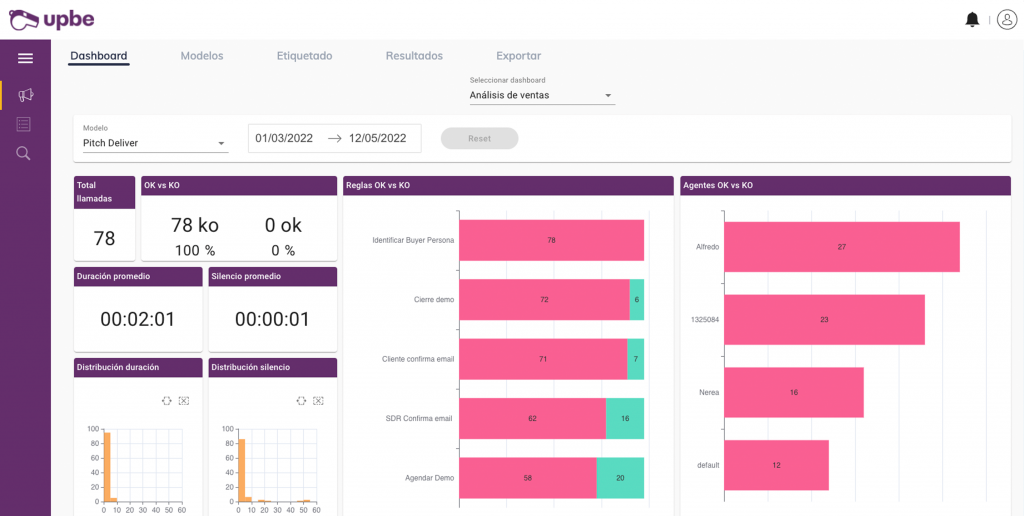
We are all familiar with the concept of “door to door” sales, and by that we can guess what a “cold call” must be. But do we really know what cold calling is?
Although we have never executed it, surely we have been recipients of some of these calls. We have all had the experience of answering a call from an unknown number where the person on the other end recites the presentation of a product that we do not need. And it also interrupts what we were doing! So we make any excuse, if we don’t hang up directly and even block the number so that they don’t bother us again in the future.
But, contrary to popular opinion, cold calling is still in fashion because it is still an essential sales strategy for attracting new customers.
In this article we will help you get rid of all the prejudices associated with cold calls and help you apply them to your B2B sales business. Let’s start!
What is a cold call?

Cold calling is the first phone call with a potential client that has not been previously requested. The client does not expect such a call, it is a call by surprise, that is why it is a first “cold” contact.
Cold calls receive this name because we do not know the person we are going to call, nor does he know us. We call a person who has not previously shown interest in our product or service. On the other hand, “hot” calls are those in which we have indications of a certain interest on the part of the client since they have contacted us in some way, either by downloading some content or requesting more information in a form through our website.
The intention behind a cold call is to publicize our product or service and generate interest in the user. The ultimate goal is to sell, however, since the person has not shown previous interest, it is more difficult to close a sale on this first call. Therefore, this call is useful to set a next appointment or to make a demonstration of the product that we want to sell. What we want is for our target to advance through the sales funnel towards conversion.
Cold calls are another part of the prospecting carried out by the sales team, they are a method of finding new potential clients, especially when they do not yet have the connections or the financial means to apply some marketing tools. Commercials use cold calling as a precursor to subsequent discovery calls.
Cold calling is one of the oldest lead generation channels that has been pushed aside by more popular ways of finding new leads. However, as the focus on remote sales is experiencing a resurgence, cold calling skills are once again becoming relevant.
How can cold calling benefit your business?

Cold calling has been highly questioned recently. At first glance, they may not seem like the most promising way to reach buyer personas. Many times the recipients hang up or get angry. Even a good prospect may not be receptive to a cold call, leading us to unnecessarily write him off.
In the past, cold calling was seen as more of an aggressive method of making intrusive calls, without any prior qualification, in the hope of receiving a positive response from the person on the other end of the line.
In addition to this, nobody likes to make cold calls as they are complicated and uncomfortable, especially if we do not master them, and this tends to demoralize those who have to face them. Some companies prefer other more inbound prospecting methods, such as social networks, webinars, etc. Some argue that these techniques are much less time consuming than cold calling.
Despite these opinions against cold calling, the data shows that it is effective. Although these have a conversion rate of around 2% and this may seem low, they are the most useful method to reach new contacts if we take into account the sales potential of each of them.
Benefits of cold calling
First of all, cold calls make us interact directly with the customer to determine if they are really interested in our product or service. It’s easy to ignore emails or say what sales reps want to hear to get it over with, but on a phone call it’s harder to fake it. In a call we perceive what the client feels through his voice. And, on the other hand, if the client is favorable to what we present to him, it will be the beginning of a relationship based on trust.
Secondly, although younger people tend to prefer digital interactions, behind the decision makers are still older people who prefer to answer a call.
Thirdly, in a call we obtain more information regarding the prospect’s doubts or objections. A call will help us determine the pains of the client and then use it in the sales department itself or even for marketing campaigns or in the development of our product.
Finally, forcing the sales team to execute cold calls is a good way to train them to make the rest of the calls. After a series of cold calls, calls to warmer leads will be a piece of cake for them.
Cold calling step by step

It’s time to reinvent cold calls and adapt them to the times. To do this, we are going to count the step that any sales representative must take to obtain results and not miss the opportunity to attract new clients.
For this purpose we have divided the entire cold calling process into the following steps:
Research
Agents must be prepared before picking up the phone. This preparation begins by learning about the person you are going to call, not only to break the ice but to personalize the presentation.
The fundamental data that they must know about the prospects are:
- Name
- Role in the company
- Company (and all the information related to it such as sector, location and even tools that they may be using)
- Interests of the prospect that we can obtain publicly, which will help us establish a relationship of trust with him
- Others: information on investment rounds, competitors, any recent hiring or leadership change, annual income, number of employees…
For this research, the use of social networks is key. Social networks are very powerful because of the amount of information they provide us in a simple search. In this B2B prospecting, the best tool is undoubtedly LinkedIn. In addition to being a showcase for your company, LinkedIn allows you to create a link with your future prospects.
This research is essential to know in advance if the person we are addressing makes decisions, which serves as the first filter for qualifying the prospect. This implies having previously developed an ideal customer profile or ICP. If you call those who have no authority to make decisions you will be wasting your time. However, this situation can always be redirected by requesting the correct contact.
Keep in mind that all this information is never complete or 100% reliable. We are creating an image of that person and through the call we have to confirm what is true and what is not.
It is very important to have a database or CRM where we can record all this information and complete it with subsequent calls.
Sequence of contact through different channels
Before the cold call, it is recommended to contact the prospect through other channels and lay the groundwork so that the client remembers who you are and what your company is when you call them. This can lead us to use a multichannel strategy to reach our customers. It can be via LinkedIn or by crafting a cold email.
Cold messages prior to the call must contain the following elements:
- An attractive but believable subject
- The value proposition or success stories of the company
- A simple and clear call to action
The recommendation is to use a relaxed and natural tone at all times, so that the prospect does not perceive that we are selling to him, but instead sense that we are interested in learning more about his problems and helping him solve them.
Writing a script
Scripts are good for being very clear about the messages that we want to communicate, such as the value proposition and the data that we have previously collected from the prospect to personalize our call. They help us to better structure cold calls and make them effective. But the scripts are a double-edged sword, since the naturalness of the conversation can be lost if the commercial recites them word for word, especially if it is still in the process of being trained.
One recommendation is to make an outline, template or guide and improve it as you gain more experience in calls.
The script should be structured as follows:
- Introduction: presentation and purpose of the call
- Questions: find out what problems our prospect has and how they are dealing with them
- Solution: talk about how we can help them solve those problems with our product or service
- Objections: how to handle them to turn them into an opportunity
- Closing: how to close the deal effectively
The purpose of this scheme is to keep in mind the objective of our call, which is to answer whether our value proposition fits with the client, whether we help them solve their problems and whether they really need to solve them.
Practice
Once the script is drawn up, you have to practice it. As we have said, it is very easy to tend to recite it like a robot, but practice will help us make it come naturally by memorizing it and perfecting it for the big moment.
A very common practice of sales teams is to practice together and role-play to represent different situations that salespeople may face in the future. Another option is to practice with less relevant clients to be prepared for the most relevant ones.
Pre-call planning
Before calling we have to prepare a list of clients that we are going to call. Previous research helps us sort the prospects in order from most to least important. It is more fruitful to call a few quality leads than many who are not interested. You need to set a target number of calls per week and schedule them.
We have to call at the right time. Logically, within business hours. Some suggest that there are more effective time slots, such as between 8 a.m. and 10 a.m. or from 4 p.m. to 5 p.m., but the time varies depending on the client. Above all, avoid out-of-office hours and mealtimes. It is important that we have indicated what the prospect’s schedules are to get the most out of that time. We have to make sure that they will be present. Having it scheduled on a calendar and sending a reminder helps us reduce the number of absences. There are many tools on the market to schedule calls and track them.
Next, we have to plan the duration of the calls very well. Bearing in mind that decision makers are the busiest people in the organization, they will not be available from 9 to 5. If we want to communicate with these people, the best times to call are early in the morning or late at night.
Whenever possible, we’ll avoid Mondays, as that’s when people are settling into their work week, and Fridays, when they’re winding down for the weekend. By the middle of the week, the target person will generally have addressed the most pressing issues and will be less likely to perceive our call as a distraction.
Likewise, we have to plan an optimal cadence of calls for each prospect. Cold reach doesn’t mean harassing the same contact endlessly for months. If that is happening, it is because an investigation work has not been done since we are not finding the decision makers. It is recommended to use about four or five calls in our cadences, and once the cadence is over, hand the contact over to marketing for nurturing. If the voice mail jumps, it is another opportunity to leave an attractive message where we can quickly summarize the value proposition and deliver a compact and effective summary of our product.
Finally, before picking up the phone, we must make sure that we are very clear about the objective we expect from this call and what would be the steps to follow based on one result or another. The ultimate goal of cold calling is to generate awareness and interest in the product and the company, and ultimately set up a future meeting to demonstrate the product’s capabilities. If sales reps remember the end goal, they will keep the conversation on track and avoid endless calls. This way, they will have more time to make other cold calls and improve sales results.
Introduction

Once we have finished the process of preparing and practicing to make better cold calls, it is time to make them. The moment of the introduction is responsible for leaving the first impressions on our prospect, so our presentation is very important, as it sets the tone for how the rest of the call will unfold.
To begin with, commercials must introduce themselves indicating their name, that of their company and the reason for the call. Using the full name and company name makes us sound more important and formal. Putting our prospect in context by stating the reason for the call reassures them by revealing the reason for that call.
Let’s not be generic, let’s personalize the conversation by calling our interlocutor by name. If it’s not too complicated, let’s explain to potential customers how we got their contact details, to add authority to calls and increase the chances that customers will let their guard down.
Let’s not start the conversation with “Is now a bad time?” because this gives our prospect an outlet before we start our pitch. It is better to ask them something about themselves (for example, “how are you?”), which often catches them off guard. This makes the call seem more personal and natural and increases the chances of success.
There are two possible scenarios when we call:
- The prospect has seen our email and already has a general idea of the product we want to present.
- The potential customer has not seen the email, so you can retrieve it and start a discussion. It usually happens quite often that a prospect will look for your emails in their spam.
We must give our prospects a reason to listen to us. Let’s start with a pain point that they may have. Think of a cold call as an elevator pitch to get to the heart of the matter quickly and decisively.
Practice active listening
To keep the meeting interactive and prevent it from turning into a pitch session for our product, we need to ask questions that lead us to better understand the prospect’s needs. Active listening is an important part of your sales strategy, both on calls and in person.
One tactic that shows that we are listening is to repeat the details that the client has communicated to us to make sure that we have understood them correctly. Being phone calls, we have to give verbal signals that we are paying attention.
Despite this, it is important to note that a cold call is not a discovery call. A discovery call is all about listening (twice as much as we talk). A cold call is all about talking (selling the meeting). Using active listening does not imply giving up having the weight of the conversation.
Asking does not mean questioning. Rehearsing the script, as we have explained before, serves to make the client feel relaxed and tell us everything we need to know, not that they feel part of an interrogation. For this purpose, it is good to mix the questions in the middle of the conversation and let it flow so that they do not perceive that it is a sales call.
Let’s avoid short questions and ask open questions. These help us to obtain specific relevant information and help us to collect more information.
Qualification
One of the main objectives of our first call to a potential client is to confirm that we are communicating with the right person. In this way, we will quickly know if it is worth continuing the call. It’s better to spend ten minutes making sure we’re talking to the right person than to deliver our speech to the wrong one.
There are many different sales qualification methods, but one of the oldest and most popular sales qualification methods is BANT (Budget, Authority, Need, Timeline). This method focuses on determining your budget, whether you are a decision maker, whether you need our product or service, and an estimated purchase timeline:
- Budget: Do you have a budget set aside for this purchase?
- Authority: Who else will be involved in the purchase decision?
- Need: What challenges are you struggling with?
- Timeline: How quickly do you need to solve your problem?
We can increase our chances by making sure we talk to the right person, meaning someone who our solution is relevant to and who has the power to make a purchase or sale. We have to bear in mind that, although the latter may not be the decision maker within the organization, they can be just as useful and easier to contact so that they end up referring us to our buyer person within the company.
Generate interest in our value proposition
The ultimate goal is to understand our buyer’s pain point, determine what their business need is, and establish the next step. We have to think about the value proposition that we are going to provide to our target audience.
This is the time to sell the meeting. Successful cold calling involves making some type of sales pitch. The following steps should be carried out:
- Mention your competitor: This shows that we understand the picture.
- Describe their pain: it shows that we know what matters most to them, what they are struggling with.
- Deliver the value: We tell them what they need to do to eliminate the pain.
- Selling the meeting: We are inviting them to a meeting without directly mentioning our product or service. “You can judge for yourself” is a great phrase to sell the meeting, not the product.
The objective is to show why the tool is essential for them. But the priority for us is to get some feedback on the product. The better we know the needs of our prospects, the better our value proposition will be in the future.
Accept rejection
Rejection is part of cold calling and is very common. Objections and rejections are a big part of the B2B cold calling process, and they happen all the time.
You have to know how to differentiate a rejection from what it is not. That they tell us that they are busy, they are short of time and that it is better that we send them that information by mail does not imply a rejection, at least not automatically. It is good to ask when they will be available and schedule it that very moment.
Let us always look for a way to transform an objection into an opportunity. But if it’s a resounding no, let’s thank them for their time and end the call politely. Asking our prospects for feedback always helps us understand why the conversation hasn’t progressed further.
It is important not to take rejection personally, it is not necessarily a reflection of us either as people or as professionals.
Call to action
Let’s remember that the main objective of cold calling is to schedule an appointment. Sometimes you even need to force it a bit. If we have a call to action (CTA), we will push potential customers to act after the call and make a decision.
If we have sold the meeting and we have obtained a favorable response from the client, it is time to make the real meeting official. The cold calling call to action is to continue the conversation by scheduling the second call to the customer, setting up a presentation or a demo.
Track
Some of the most successful cold calls involve additional time to discuss next steps at the end of the conversation, after the meeting has been added to our buyer’s calendar. Let’s not forget that we are laying the foundations for a better relationship with our future clients.
Once we end the call and have set a next meeting on the calendar, we need to schedule the next steps. After the cold call, we send an email to our client summarizing what was discussed in the call and remembering the date of the next meeting.
Following up is also starting another chain of contactability. The ideal cadence includes an equal number of emails and some social media touches. The best place to follow up is where we first made contact.
Keep practicing and improving
Cold calls should continue to be reviewed after they are finished. It is essential to include this step in the training of the sales team so that they learn from their mistakes. One does not become the best salesperson without training.
Things not working? Be aware of where you might be going wrong. The nature of cold calling means that even the most skilled salesperson will never have a 100% success rate, but if you are having bad luck, let’s take a closer look and make sure there’s nothing we can do better to improve.
We must follow all this progress with data. Use KPIs to measure success. Metrics are as key to cold calling as they are to any other area of sales: monitoring the cold calling funnel to see how it’s doing, listening to the best cold calls of the week, spotting “key phrases” that make a difference with prospects, etc.
Training and practice will also help us learn to deal with rejection smoothly. Cold calling can be the downfall of many sales reps, and even the most skilled and motivated can run into trouble.
Perfect the art of cold calling thanks to the use of AI
The only way to get good at cold calling is through practice and experience. You won’t become a skilled cold caller overnight. This is what we can do to improve our cold calls:
Record every call with a potential client
This can help us review important parts of the conversation later to track our performance and improve.
Take notes for additional information
After ending a call while it’s still fresh, let’s write down any information we feel is important.
Peer coaching
This process may involve each rep commenting on a teammate’s cold call, highlighting two positives and two things for improvement.
Manager-Led Training
This type of coaching usually takes place on a one-on-one basis, where the representative presents one of their cold calls to their manager for review and analysis. Typically, in these sessions, the manager will focus on helping the rep develop a specific skill, such as how to handle objections or ask engaging questions.
Group review
This process occurs when a representative sends out a cold call for review and feedback is shared by the entire group. The person who sent the call first makes a self-criticism of the call before the whole group intervenes.
Collaborate with other departments
Let other product, customer success, and marketing teams listen in on the calls. Work with them to improve our tone of voice, rate of speaking and choice of words. Review our cold calling scripts and ask for their input.
We can also take advantage of technologies to strengthen the skills of our team and make the cold calling process more efficient and productive. Technology plays a key role in making our cold calling process more efficient and effective. So, in addition to maximizing the cold calling tips outlined above, we need to make sure that we and our team are employing the right technologies.
We can’t effectively use our B2B cold calling skill set without proper automation. Of course, by now, we must have already chosen a dialer to contact prospects in our CRM. So, let’s talk about the last piece of the puzzle. An important part of your cold calling will be the intelligence we get during the call and after the call.
An easy way to capture and analyze that information is with the help of conversation intelligence software. Upbe captures millions of customer data points (anonymized, of course) from phone calls to web conference meetings. We combine that data with our AI tool to analyze the buyer-seller relationship, specifically how various actions (and inactions) and behaviors affect success rates.

We hope these cold calling tips and best practices have been helpful in helping you be more successful at converting prospects who weren’t expecting you to call them into customers who are so glad you did.





3 Comments
Comments are closed.